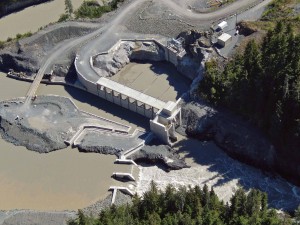
Tree for Life Award: Forrest Kerr Hydroelectric Project
October 24, 2015
By Hatch
“At this remote dam project in Northern B.C. the engineers used innovative and sustainable techniques, such as carefully protecting the fish habitat downstream with a creative use of turbines to quickly offload the power when necessary. The project involved First Nations and produces 195 MW of clean energy with minimal impact on their ancestral lands.” – Jury

Forrest Kerr Hydroelectric Power Project, Iskut River, B.C. Aerial View. Image: Hatch
Eight months into the construction program of the Forrest Kerr Hydroelectric project, independent power producer AltaGas turned to Hatch to solve some serious design issues that threatened the viability of the project. Becoming prime consultant, Hatch mobilized a team to complete the detailed design. The work included the development of innovative concepts that solved engineering challenges at both the headworks and powerhouse locations.
The 195 MW project located 100 kilometres northwest of Stewart in Northern B.C. involved not only multi-disciplinary engineering coordination, but also First Nations collaboration and sustainability.
Headworks mixes inflow of two rivers
For the headworks located at the convergence of the Iskut River and Forrest Kerr Creek, the Hatch design team developed an intake and sediment handling system that included optimizing the geometry of the various structures to “mix” the inflow of two converging rivers.
The sediment handling and flushing system relies on a highly effective concrete box culvert design, which splits the sluiceway channel into an upper and lower compartment. The largest and heaviest material, travelling naturally at the bottom of the watercourse, is directed through the lower compartment of the structure. The tapered design of the structure ensures that water and bedload material are continually accelerated through the culvert and discharged back into the river.
The upper portion of the water course remains on the upper level of the box culvert and is diverted to the de-sanding basin, which provides for a second level of filtration. The basin slows the water and allows particles larger than 2 mm to settle out and then be automatically flushed back into the river.
The design of the sluiceway and approach channel prevents large bedload material from entering the facility. A desander with 8 “V”-shaped sediment collection chambers was designed and equipped with an automatic flushing system capable of completely flushing the desander without impacting plant operations.
The convergence of the two rivers upstream of the intake area produces highly complex flow conditions (ranging from 10 m3/s to over 5000 m3/s). Numerical flow modelling and the construction of a comprehensive physical model helped achieve an ideal configuration for the various headworks structures.
Powerhouse flow ramping
The underground powerhouse and headworks had to be constructed on unstable volcanic rock, requiring complex engineering solutions.
To further complicate matters at the powerhouse, “flow ramping” rates were imposed that limited water level fluctuations downstream of the facility to 2 cm/hr in order to protect and enhance important fish habitat. It was therefore not possible to simply turn off the flow of water through the turbines following a full plant shutdown.
A solution needed to be found that allowed the flow to be gradually shut off, dissipating the energy in the water before it is returned to the river. The only practical solution: allow the water to pass through the turbines “freewheeling” at twice their normal speed. Hatch engineers were able to double-up on the functionality of the Francis turbines by replacing the two large 83 MW and two small 23 MW units of the original design with nine 23.5 MW units.
The design of the headworks includes a return channel to allow any fish caught in the sluiceway to easily return to the natural river. Indeed, the choice of the site itself was ideal for use as a hydroelectric development since the canyon that separates the water intake from the powerhouse acts as a natural barrier for fish, preventing them from entering the diversion reach.
Working with First Nations on clean energy
The dream of First Nations people is to live in harmony with nature — and the Tahltan First Nation is no exception. The Iskut River is the largest tributary of the Stikine, one of three rivers that originate in the Sacred Headwaters of this community. The local First Nations community has been directly involved in the success of the Forrest Kerr project by providing a third of the construction workforce. Moreover, First Nations staff holds a number of permanent key positions in the AltaGas operations monitoring groups.
To further minimize the project’s environmental footprint, Hatch recorded different types of construction materials available locally and used them whenever possible. Waste rock from the excavation and blasting of underground tunnels was recovered to serve as a structural base for the foundation of the switchyard. In addition, 20,000 m3 of loam was recovered from the excavation of the headworks and used as conductive backfill to improve the ground resistivity and electrical safety of the switchyard.
The project generates clean energy to supply 70,000 homes. It strengthens the power transmission system in Northern B.C. and will serve as a major catalyst for economic development in this remote area.
Project name: Forrest Kerr 195 MW Hydroelectric
Power Project, Iskut River, B.C.
Award-winning firm (prime consultant): Hatch, Vancouver (Shawn Smith, P.Eng.,
Neil Ferguson, P.Eng., Doug McAndrew, P.Eng., Raj Mannem, P.Eng., Tim Dean, P.Eng.,
Don Murray, P.Eng., Adeel Afzal, P.Eng.,
Mark Kellaway, C.Geol., David Pinese, P.Eng., Ccee Chan, P.Eng.)
Owner: AltaGas
Physical hydraulic modeling: Northwest Hydraulic Consultants